Celtic - Jewellery - Classical antiquity - Sold antiquities
Archive of sold antiquities
All artefacts sold in our gallery are fully documented in our online archive and database. Being a specialist ancient art dealer, preserving also the more recent history of each and every piece sold in our shop is at our heart. That is particularly useful for artefacts that changed owners in the meantime. Information that may have been lost in the process can be easily restored from our archives. Please do not hesitate to contact us if you need further information about ancient items that have been sold in our gallery. We can help you with reconstructing the history of ownership for those items. All information about our customers will be kept confidential, of course.-
 Disc brooch from Roman Britain
Disc brooch from Roman BritainBrooch with a Romano-Celtic sunburst design. Circa 2nd century. A find from Roman Britain
Price: on request Trumpet brooch with Celtic decorations
Trumpet brooch with Celtic decorationsUnusual and rare variant of high importance, published several times. Beautiful silver inlays on the bow showing tendrils in Celtic style. From the 1st century.
Price: on request Disc brooch from Roman Britain
Disc brooch from Roman BritainNicely enameled brooch with a Romano-Celtic sunburst design. From the 2nd century AD. Published in two stardard works on ancient brooches by Richard Hattatt.
Price: on request Dolphin brooch from Roman Britain
Dolphin brooch from Roman BritainThe so-called dolphin brooch is very British. This specimen was probably made by the Celtic Corieltauvi tribe, shortly after the arrival of the Romans in the middle of the 1st century. Published in two works by Richard Hattatt.
Price: on request Celtic penannular brooch
Celtic penannular broochPossibly made by the Celtic Durotriges tribe under Roman rule in Britain. The piece is published in two books by Richard Hattatt.
Price: on request Ancient brooch of a fabulous creature
Ancient brooch of a fabulous creatureRare Hippocampus brooch with elaborate inlays of multi-coloured glass paste and metal. Great example of the brooch manufacturing of Roman Gaul during the mid 1st cent. AD.
Price: on request Roman plate brooch with colourful enamel
Roman plate brooch with colourful enamelRare fibula type from Roman Britain. The fully intact multicoloured enamel makes this piece worthy of being a museum exhibit. 2nd cent. AD.
Price: on request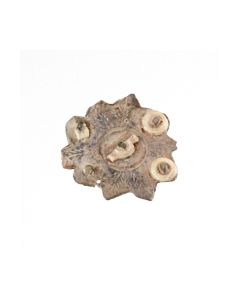 Elaborate Roman plate brooch
Elaborate Roman plate broochTen pointed star form with leaf pattern and decorative buttons. A product of Gaul or Britain dating to the 1st century.
Price: on request Celtic fibula from the famous Hattatt collection
Celtic fibula from the famous Hattatt collectionFibula from the La Tène II period. Found in Celtic Carnuntum. The piece is published in the standard work "Iron Age and Roman Brooches".
Price: on request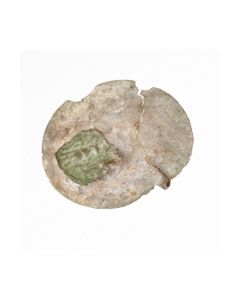 Ancient fibula from the Hattatt collection
Ancient fibula from the Hattatt collectionAncient fibula of the rare adlocutio type. Repoussé work of a scene from a Roman sestertius of Hadrian in celtic style. Find from Dorset in Roman Britain. Published in Hattatts famous book series on ancient fibulae.
Price: on request Published Roman fibula with celtic design
Published Roman fibula with celtic designAncient fibula from the Roman province of Britain. The design can be attributed to the celtic tribe of the Trinovantes or Iceni. From the famous Hattatt collection. Published twice.
Price: on request Gruppe römischer Ringe
Gruppe römischer RingeDiverse Ringe aus Bronze. 1. bis 4. Jh. n.Chr., römische Epoche. Germania Inferior.
Price: on request Keltisch-römische Ringfibel
Keltisch-römische Ringfibel1. Jh. v.Chr. bis 1. Jh. n.Chr., Ende der keltischen Epoche, Beginn der römischen. Hervorragender Zustand, schön patiniert, mit Nadel. Rautenförmiger Querschnitt.
Price: on request 2 Perlen mit aufgeschmolzenem Glas
2 Perlen mit aufgeschmolzenem GlasBlaue Glasperlen in Langform mit Spirale aus weißem aufgeschmolzenem Glas. Grabbeigabe der Kelten oder Römer.
Price: on request Römische Silberfibel
Römische SilberfibelMassive Fibel aus Silber. Fundort England, aus alter britischer Sammlung. Museumswürdiges Exemplar.
Price: on request Römische Nadel aus Bein
Römische Nadel aus BeinNadel oder Haarnadel aus Bein. Kunstvoll gearbeiteter Kopf. Fundort: White Noteley, Essex, England.
Price: on request Keltische Fibel aus Silber
Keltische Fibel aus SilberSeltener Typ mit Dekor, 1. Jh. v. Chr. - 1. Jh. n. Chr. Museales Stück mit schöner Tönung.
Price: on request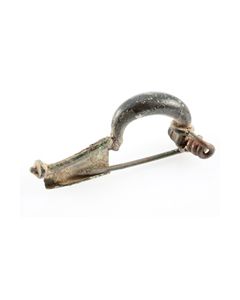 Keltische Fibel mit P-förmigem Profil
Keltische Fibel mit P-förmigem ProfilKeltische Fibel, Variante aus der La Tène-Zeit. Interessanter, massiver Typ aus dem 3. bis 1. Jh. v. Chr. 63mm lang, 25g.
Price: on request Keltische Fibel aus der La Tene II-Zeit
Keltische Fibel aus der La Tene II-ZeitBronzefibel des 2. bis 1. Jh. v. Chr. Mit ihrer eleganten, einfachen Ausführung ein Musterbeispiel einer La Tene-Zeit-Fibel in museumswürdiger Erhaltung.
Price: on request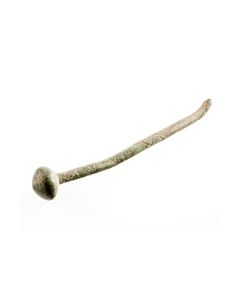 keltische - römische Gewandnadel oder Haarnadel aus Bronze
keltische - römische Gewandnadel oder Haarnadel aus BronzeSehr gut erhalten, leicht verbogen. Schöne Patina, kunstvoll gearbeitet.
Price: on request römisches Amulett in Form eines Beilkopfs
römisches Amulett in Form eines BeilkopfsAmulette dieser Art sind bereits aus dem 4. - 2. Jh. v. Chr. bei keltischen Stämmen belegt. In dieser Erhaltung selten.
Price: on request Früher Fibeltyp mit Zierplatte
Früher Fibeltyp mit ZierplatteAntike Fibel mit emaillierter Zierplatte. Schön patinierter Bronzekörper mit reichem Dekor. 2. Jh. v. Chr. bis 1. Jh. n. Chr.
Price: on request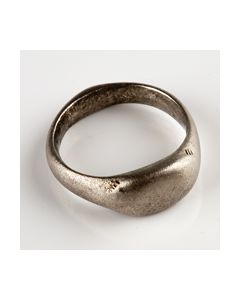 Römischer Ring aus Silber
Römischer Ring aus SilberRömische Kaiserzeit, möglicherweise aus der keltischen Provinz oder Provinznähe. Ringband geht nahtlos in die Ringplatte über. Theoretisch auch heute noch als Amulett oder Fingerring tragbar. Innendurchmesser 17mm bis 18mm.
Price: on request Roman sandal sole type fibula
Roman sandal sole type fibulaDie Form wird in der Literatur als Schuh- oder Sandalensohle bezeichnet. Der sehr dekorative Fibeltyp war extrem beliebt und im zweiten Jahrhundert weit verbreitet. Er stammt aus den nördlichen römischen Provinzen.
Price: on request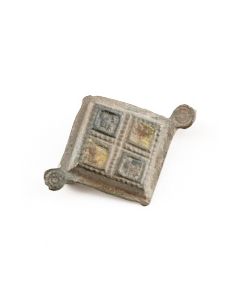 Impressively preserved enameled Roman brooch
Impressively preserved enameled Roman broochIn Britannien und Gallien produzierter Fibeltyp des zweiten Jahrhunderts. Edel patinierte Bronzeoberfläche. Besonders hervorzuheben ist die Emailauflage in selten gutem Erhaltungszustand.
Price: on request Enameled Galo-Roman fibula
Enameled Galo-Roman fibulaGrundform einer rechteckigen Platte, erweitert durch Zierknopf an Kopf- und Fußende. Drei Paare von Dreiecken auf der Platte sind durch weiße Einlagen hervorgehoben. Etwa 2. Jh. n. Chr.
Price: on request Rare discus-shaped Celtic-Roman fibula
Rare discus-shaped Celtic-Roman fibulaAus der Entstehungszeit der plattenförmigen Fibeln, 1. Jh. n. Chr. Ästhetisch ansprechende Metallarbeit aus einer Fusion keltischer Handwerkstraditionen mit römischen Vorlieben.
Price: on request Gallo-Roman animal fibula
Gallo-Roman animal fibulaZoomorphe Fibel mit Wildtier als Motiv. Schmuckstück mit religiöser Symbolik, vergleichbar einem Kreuzanhänger bei heutigen Christen. Gefertigt im 1. bis 3. Jh. n. Chr. in Gallien.
Price: on request Roman discus fibula with color glass paste
Roman discus fibula with color glass pasteSpannende Fibel mit Sterndekor und Glaspaste. Eine Weiterentwicklung keltischen Kunsthandwerks in der Zeit römischer Herrschaft. Gut dokumentierter Typ aus dem 2. Jh. v. Chr. mit Verbreitung in weiten Teilen Europas.
Price: on request

